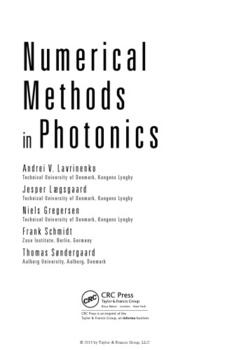Table Of ContentN u m e r i c a l
M e t h o d s
P h o t o n i c s
in
Andrei V. Lavrinenko
Technical University of Denmark, Kongens Lyngby
Jesper Lægsgaard
Technical University of Denmark, Kongens Lyngby
Niels Gregersen
Technical University of Denmark, Kongens Lyngby
Frank Schmidt
Zuse Institute, Berlin, Germany
Thomas Søndergaard
Aalborg University, Aalborg, Denmark
Boca Raton London New York
CRC Press is an imprint of the
Taylor & Francis Group, an informa business
© 2015 by Taylor & Francis Group, LLC
MATLAB® and Simulink® are trademarks of the MathWorks, Inc. and are used with permission. The Math-
Works does not warrant the accuracy of the text or exercises in this book. This book’s use or discussion
of MATLAB® and Simulink® software or related products does not constitute endorsement or sponsorship
by the MathWorks of a particular pedagogical approach or particular use of the MATLAB® and Simulink®
software
CRC Press
Taylor & Francis Group
6000 Broken Sound Parkway NW, Suite 300
Boca Raton, FL 33487-2742
© 2015 by Taylor & Francis Group, LLC
CRC Press is an imprint of Taylor & Francis Group, an Informa business
No claim to original U.S. Government works
Version Date: 20140707
International Standard Book Number-13: 978-1-4665-6389-6 (eBook - PDF)
This book contains information obtained from authentic and highly regarded sources. Reasonable efforts
have been made to publish reliable data and information, but the author and publisher cannot assume
responsibility for the validity of all materials or the consequences of their use. The authors and publishers
have attempted to trace the copyright holders of all material reproduced in this publication and apologize to
copyright holders if permission to publish in this form has not been obtained. If any copyright material has
not been acknowledged please write and let us know so we may rectify in any future reprint.
Except as permitted under U.S. Copyright Law, no part of this book may be reprinted, reproduced, transmit-
ted, or utilized in any form by any electronic, mechanical, or other means, now known or hereafter invented,
including photocopying, microfilming, and recording, or in any information storage or retrieval system,
without written permission from the publishers.
For permission to photocopy or use material electronically from this work, please access www.copyright.
com (http://www.copyright.com/) or contact the Copyright Clearance Center, Inc. (CCC), 222 Rosewood
Drive, Danvers, MA 01923, 978-750-8400. CCC is a not-for-profit organization that provides licenses and
registration for a variety of users. For organizations that have been granted a photocopy license by the CCC,
a separate system of payment has been arranged.
Trademark Notice: Product or corporate names may be trademarks or registered trademarks, and are used
only for identification and explanation without intent to infringe.
Visit the Taylor & Francis Web site at
http://www.taylorandfrancis.com
and the CRC Press Web site at
http://www.crcpress.com
© 2015 by Taylor & Francis Group, LLC
OPTICAL SCIENCES AND APPLICATIONS OF LIGHT
Series Editor
James C. Wyant
Numerical Methods in Photonics, Andrei V. Lavrinenko, Jesper Lægsgaard,
Niels Gregersen, Frank Schmidt, and Thomas Søndergaard
Please visit our website www.crcpress.com for a full list of titles
© 2015 by Taylor & Francis Group, LLC
Dedication
Toourfamiliesandparents
© 2015 by Taylor & Francis Group, LLC
Contents
SeriesPreface.........................................................................xiii
Preface .................................................................................xv
Authors............................................................................... xvii
Acronyms.............................................................................xix
Chapter1 Introduction..............................................................1
Chapter2 Maxwell’sEquations ....................................................5
2.1 Notation............................................................5
2.2 Maxwell’sEquations..............................................5
2.3 MaterialEquations................................................6
2.4 FrequencyDomain................................................7
2.5 1Dand2DMaxwell’sEquations.................................9
2.6 WaveEquations ..................................................11
2.7 WaveguidesandEigenmodes....................................13
2.7.1 EigenvalueProblem.....................................14
2.7.2 SlabWaveguides ........................................16
2.7.3 BoundaryConditionsandEigenmodeClasses.........17
2.7.4 Orthogonality............................................18
References...............................................................22
Chapter3 Finite-DifferenceTime-DomainMethod..............................23
3.1 Introduction.......................................................23
3.1.1 Finite-DifferenceApproximationsofDerivatives .....24
3.1.2 Finite-DifferenceApproximationof1D
Maxwell’sEquations....................................27
3.1.3 Fortran,C,MATLAB(cid:2),Etc.,Adaptationofthe
FDTDMethod...........................................30
3.1.4 FDTDMethodin3D....................................31
3.1.5 FDTDMethodin2D....................................34
3.2 NumericalDispersionandStabilityAnalysisofthe
FDTDMethod....................................................34
3.2.1 DispersionEquationin3D..............................35
3.2.2 NumericalStabilityCriteria.............................37
3.2.3 Divergence-FreeCharacteroftheFDTDMethod .....39
3.3 MakingYourOwn1DFDTD....................................42
3.3.1 Step1:SettingMaterialPropertiesonaGrid..........43
3.3.2 Step2:SettingSourcesandDetectors..................46
vii
© 2015 by Taylor & Francis Group, LLC
viii Contents
3.3.3 Step3:EvolvingFields .................................48
3.3.4 Step4:PostprocessingofInformation .................49
3.4 AbsorbingBoundaryConditions................................50
3.4.1 AnalyticalAbsorbingBoundaryConditions...........51
3.4.2 PerfectlyMatchedLayer:BasicIdea...................52
3.4.3 PerfectlyMatchedLayer:Generalizationand
Realization...............................................55
3.5 FDTDMethodforMaterialswithFrequencyDispersion......58
3.5.1 FrequencyDispersionModels..........................58
3.5.1.1 DebyeMaterial ...............................58
3.5.1.2 DrudeModel..................................59
3.5.1.3 LorentzModel................................60
3.5.2 NumericalImplementationofFrequency
DispersioninFDTDthroughAuxiliaryEquation .....60
3.5.2.1 DebyeMaterial ...............................61
3.5.2.2 DrudeModelofDispersion..................63
3.5.2.3 LorentzModelofDispersion ................63
3.5.3 LinearPolarizationModelforDispersive
MaterialsinFDTD ......................................64
3.5.4 PiecewiseLinearRecursiveConvolution
Scheme...................................................66
3.6 FDTDMethodforNonlinearMaterials,Materialswith
Gain,andLasing .................................................67
3.6.1 NonlinearPolarizationinFDTD........................67
3.6.2 MediumwithGain:PhenomenologicalApproach
inFDTD .................................................69
3.6.3 LasinginFDTD.........................................69
3.7 Conclusion........................................................71
Exercises ................................................................71
References...............................................................74
Chapter4 Finite-DifferenceModellingofStraightWaveguides.................77
4.1 Introduction.......................................................77
4.2 GeneralConsiderations ..........................................77
4.2.1 TimeDomainversusFrequencyDomain ..............77
4.2.2 Finite-DifferenceMethodsforStraight
Waveguides..............................................78
4.3 ModifiedFinite-DifferenceOperators...........................80
4.3.1 DiscretizingtheScalarWaveEquation.................80
4.3.2 InclusionofDiscontinuities:GeneralFormalism......83
4.3.3 InclusionofDiscontinuities:TECase..................86
4.3.4 InclusionofDiscontinuities:TMCase.................87
4.4 NumericalLinearAlgebrainMATLAB........................88
4.4.1 SparseMatrices..........................................88
4.4.2 DirectandIterativeEigensolvers.......................89
© 2015 by Taylor & Francis Group, LLC
Contents ix
4.5 2DWaveguidesandtheYeeMesh ..............................92
4.5.1 YeeMesh ................................................92
4.5.2 DielectricFunctionAveraging..........................95
4.5.3 UseofMirrorSymmetries..............................99
Exercises .............................................................. 102
References............................................................. 106
Chapter5 ModellingofNonlinearPropagationinWaveguides................ 107
5.1 Introduction..................................................... 107
5.2 Formalism ...................................................... 108
5.2.1 GeneralPropagationEquation........................ 108
5.2.2 PulsePowerandPulseEnergy........................ 110
5.3 NonlinearPolarization......................................... 111
5.3.1 NonlinearProcesses................................... 112
5.3.2 χ(3)NonlinearProcesses .............................. 114
5.3.3 Single-ModePropagationModel..................... 115
5.4 NonlinearSchrödingerEquation .............................. 120
5.4.1 DerivationoftheNLSEquation...................... 120
5.4.2 DispersionandSelf-PhaseModulation .............. 122
5.4.3 OpticalSolitons........................................ 124
5.4.4 SolitonsandRamanEffects........................... 125
5.4.5 Self-Steepening........................................ 126
5.4.6 ConservationLaws.................................... 127
5.5 NumericalImplementation .................................... 129
5.5.1 FourierMethod........................................ 129
5.5.2 SteppingTechniques.................................. 130
5.5.3 DiscreteFourierGrids................................. 132
5.5.4 ImplementationinMATLAB......................... 134
Exercises .............................................................. 136
References............................................................. 137
Chapter6 TheModalMethod ................................................... 139
6.1 Introduction..................................................... 139
6.2 Eigenmodes..................................................... 140
6.3 1DGeometry................................................... 142
6.3.1 RecursiveMatrixFormalism.......................... 143
6.3.2 1DInterface............................................ 145
6.3.3 MultilayerStructure................................... 146
6.3.4 1DCavity.............................................. 149
6.4 2DGeometry................................................... 150
6.4.1 Plane-WaveExpansion................................ 151
6.4.1.1 Li’sFactorizationRules.................... 151
6.4.1.2 EigenvalueProblem ........................ 153
6.4.2 Semi-AnalyticalApproach............................ 157
© 2015 by Taylor & Francis Group, LLC
x Contents
6.4.3 Interface................................................ 162
6.4.4 SMatrixTheory....................................... 166
6.4.5 AbsorbingBoundaryConditions ..................... 171
6.5 PeriodicStructures............................................. 176
6.5.1 BlochModes........................................... 177
6.5.2 Classification .......................................... 180
6.5.3 Interface................................................ 182
6.5.4 FieldProfileinaPeriodicElement................... 184
6.6 CurrentSources ................................................ 185
6.6.1 UniformLayer......................................... 186
6.6.2 MultilayerGeometry.................................. 188
6.7 3DGeometries ................................................. 190
Exercises .............................................................. 191
References............................................................. 194
Chapter7 Green’sFunctionIntegralEquationMethodsfor
ElectromagneticScatteringProblems ............................... 197
7.1 Introduction..................................................... 197
7.2 TheoreticalFoundation ........................................ 198
7.3 Green’sFunctionAreaIntegralEquationMethod............ 198
7.4 Green’sFunctionVolumeIntegralEquationMethod......... 204
7.5 Green’sFunctionSurfaceIntegralEquation
Method(2D).................................................... 209
7.5.1 SurfaceIntegralEquations............................ 209
7.5.2 CalculatingtheFieldandNormalDerivative
attheBoundary........................................ 212
7.6 Constructionof2DGreen’sFunctionsfor
LayeredStructures ............................................. 218
7.6.1 Plane-WaveExpansionoftheFree-Space
Green’sFunction ...................................... 219
7.6.2 2DTE-PolarizedScalarGreen’sFunctionfora
LayeredStructure...................................... 222
7.6.3 2DTM-PolarizedScalarGreen’sFunctionfora
LayeredStructure...................................... 224
7.6.4 FresnelReflectionandTransmissionCoefficients
foraFewSimpleGeometries......................... 224
7.6.5 CalculatingtheSommerfeldIntegral................. 226
7.6.6 Far-FieldApproximation.............................. 228
7.6.7 ExcitationofBoundWaveguideModes ............. 230
7.7 ConstructionofthePeriodicGreen’sFunction............... 233
7.7.1 1DPeriodicScalarGreen’sFunctionfora
LayeredStructure...................................... 234
7.8 ReflectionfromaPeriodicSurfaceMicrostructure........... 234
7.8.1 CalculatingReflectionandTransmission............ 237
© 2015 by Taylor & Francis Group, LLC

